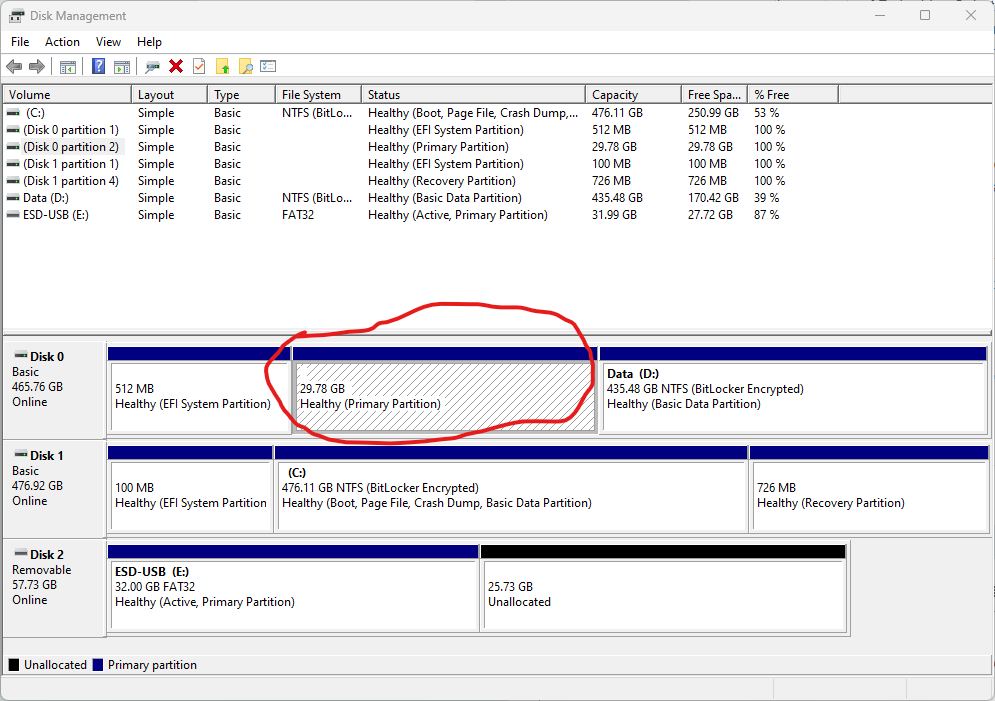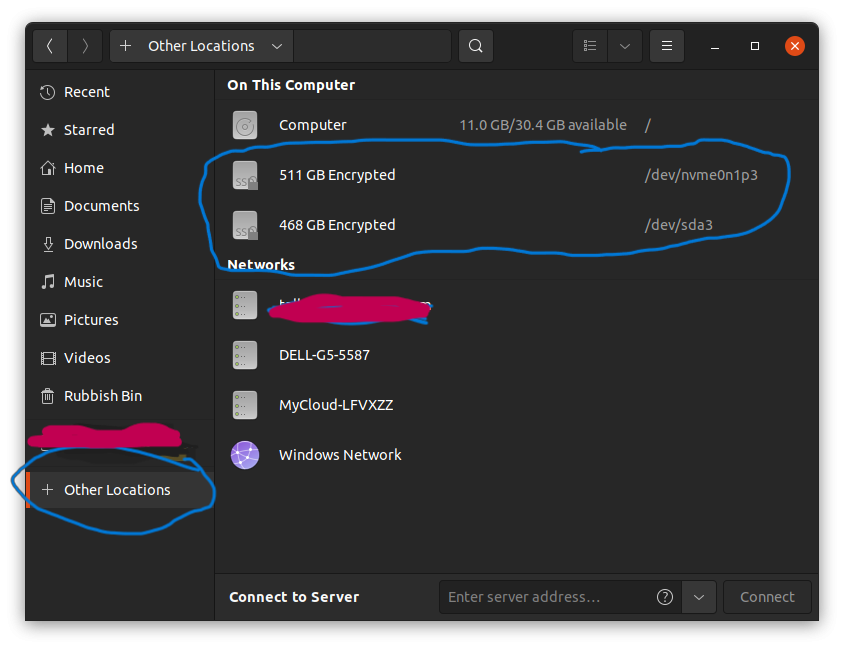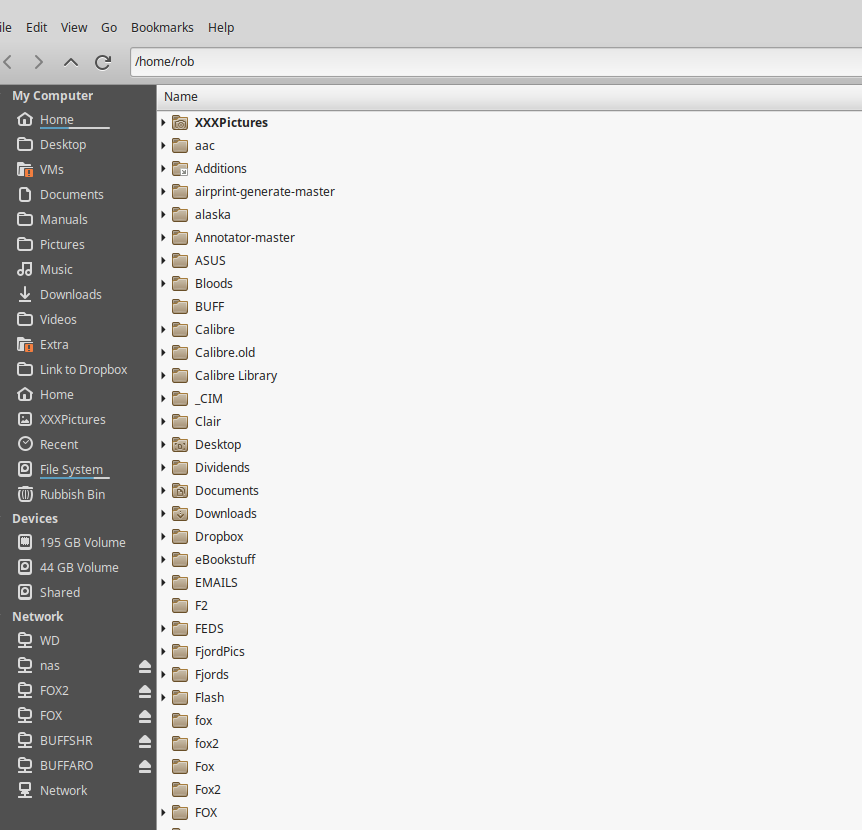We’d like to remind Forumites to please avoid political debate on the Forum.
This is to keep it a safe and useful space for MoneySaving discussions. Threads that are – or become – political in nature may be removed in line with the Forum’s rules. Thank you for your understanding.
📨 Have you signed up to the Forum's new Email Digest yet? Get a selection of trending threads sent straight to your inbox daily, weekly or monthly!
'Hiding' a drive from Linux..?
JustAnotherSaver
Posts: 6,709 Forumite






in Techie Stuff
So for Windows 7 at least on a dual boot Win 7 and Win 7 (yes you read that right and for the point of the thread, it doesn't matter)....
Control Panel > Admin Tools > Computer Management > Disk Management (yes I know there's some command to chuck in run to get here but there's more than 1 way of doing this) > Right click drive letter, let's say drive F > Change drive letter and paths > Make sure drive letter is selected & then click remove.
And that's it. The drive that you're in, C drive say, will now no longer see F drive until you reassign a letter to it.
I say that - perhaps there's an exception where C will still show it in "Computer" or you can still access the contents of F via drive C, but i'm not talking about "look at how much I know about computing" people, i'm talking about your bog standard average PC user who only goes on to browse the net, see what's in their picture folders etc.
If you dual boot Linux (probably a variation of Mint if we have to be specific - not sure which flavour though) with what will be Windows 10, is there a way of doing the same there?
Where you can dual boot no problem but once you're in that OS, be it Linux or Windows, and you select "Computer" or whatever the Linux variation is, you ONLY see the drive you're in and not the other OS drive?
If I've explained that poorly and you don't have a clue what I mean then I'll have to have another bash.
0
Comments
-
Yes.
So I have dual boot Win 11 / Ubuntu albeit on separate SSD's but the Windows OS cannot see the Linux disk at all because it is in Ext4 which Windows cannot read at all.
When I boot to Ubuntu, it would be able to see my other Windows partition because it can read NTFS but I've got Bit locker encryption enabled so it cannot see any contents whatsoever.
Circled below is my Ext4 partition. Disk 0 is my drive with Ubuntu boot partition of 30GB and the remainder is just an NTFS data drive for Windows. Disk 1 is my C: drive with Windows OS partitions only.
drive with Ubuntu boot partition of 30GB and the remainder is just an NTFS data drive for Windows. Disk 1 is my C: drive with Windows OS partitions only.
0 -
Thanks, though I wonder if you maybe have the reverse of what I'm asking?Either that or I'm the one who's misunderstood you.See, I'm not really concerned about the Windows OS not 'seeing' (showing in Computer) the Linux disk. I already know how to 'hide' another drive within Windows so I'd just do that.My concern/question is about hiding Windows from Linux once you've booted to the Linux disk.I know you say you've got Bitlocker encryption enabled but I'm guessing once inside Linux, you can still 'see' the Windows drive even if you can't access it?I'm talking about hiding it altogether, so it just simply can't be seen.I could always install to a spare SSD and either 1) connect via USB (which will be slow as hell) 2) open the case and insert the SSD whenever I wish to boot to Linux (no thanks) or 3) Virtual Machine it (again, no thanks) but the preference would be to have a dual boot for easiness.0
-
did a google and found this - not sure if it applied to mint though...
In Ubuntu 12.10 and onward, there is a utility called Disks which shows all the available disks and allows to modify mount options for each partition.
Amongst the various options, you can decide if the partition will be mounted at boot time or not, and if it will appear in the user interface. Admin privileges are needed to apply changes
0 -
No realistic way to do it unless you set up a user without sudo access as the main user, but you will still need to have a "admin" user as well. The Windows disks are not mounted at boot time anyway unless you put entries in /etc/fstab. I don't see what you are trying to gain.
4.8kWp 12x400W Longhi 9.6 kWh battery Giv-hy 5.0 Inverter, WSW facing Essex . Aint no sunshine ☀️ Octopus gas fixed dec 24 @ 5.74 tracker again+ Octopus Intelligent Flux leccy0 -
As per above comment would be useful to know more about why / what you are trying to achieve because there could be other ways of doing this.JustAnotherSaver said:Thanks, though I wonder if you maybe have the reverse of what I'm asking?Either that or I'm the one who's misunderstood you.See, I'm not really concerned about the Windows OS not 'seeing' (showing in Computer) the Linux disk. I already know how to 'hide' another drive within Windows so I'd just do that.My concern/question is about hiding Windows from Linux once you've booted to the Linux disk.I know you say you've got Bitlocker encryption enabled but I'm guessing once inside Linux, you can still 'see' the Windows drive even if you can't access it?I'm talking about hiding it altogether, so it just simply can't be seen.I could always install to a spare SSD and either 1) connect via USB (which will be slow as hell) 2) open the case and insert the SSD whenever I wish to boot to Linux (no thanks) or 3) Virtual Machine it (again, no thanks) but the preference would be to have a dual boot for easiness.
For info, in my Linux OS I can't see the contents of my Windows OS or Windows D : data drive at all. If I click on "Other locations" you can see the drive but nothing else can be viewed and therefore can't see why that doesn't meet your requirements?
When I click on them it tells me they are encrypted and need a passphrase. Ignore the red bits redacted as they show my email address.
0 -
Ok no problem I thought I was fairly clear but then it's easy for me to say that since I know what I'm wanting so we'll have another bash at it...I can't show you a screenshot from Linux as an example as I don't have Linux set up so we'll have to pretend for a second....
 This is obviously a Windows setup.So right now I boot in to Windows (7) and it shows all the physical hard disk drives that are inside the case. Some of them as far as E & G go for example, are 1 physical drive but have been partitioned in to two but it doesn't matter.Then there's the optical drives and also the removable drives. I have an SD card inserted at the moment in to L. I imagine M, N & O are all part of the unit that is also L (one of those akasa 10-in-1 things or however many in 1 things it is).So here's the pretending bit.....Let's pretend that is not Windows, let's pretend it's Linux.Right now it shows all drives. You're in C at the moment. I suspect if I double click on D/E/G/I then I will be able to access those drives (as in access the files on those drives).Right? Wrong?So if that's correct then what I am wanting to achieve is this....
This is obviously a Windows setup.So right now I boot in to Windows (7) and it shows all the physical hard disk drives that are inside the case. Some of them as far as E & G go for example, are 1 physical drive but have been partitioned in to two but it doesn't matter.Then there's the optical drives and also the removable drives. I have an SD card inserted at the moment in to L. I imagine M, N & O are all part of the unit that is also L (one of those akasa 10-in-1 things or however many in 1 things it is).So here's the pretending bit.....Let's pretend that is not Windows, let's pretend it's Linux.Right now it shows all drives. You're in C at the moment. I suspect if I double click on D/E/G/I then I will be able to access those drives (as in access the files on those drives).Right? Wrong?So if that's correct then what I am wanting to achieve is this.... Again, we're still pretending this is Linux, or Linux's version of Computer.I can only 'see' the drive that I'm in (ok I know L is showing but that's different).This would be the preferred option.If this is not possible (and we can put men on the moon so I'd be very surprised if we can't simply hide some drives in Linux) then an acceptable alternative would be to have them showing but if you double click on them then nothing happens or you get a sorry can't access that drive kind of message.Top & bottom of it is, I don't want any access to Windows drives from within Linux.0
Again, we're still pretending this is Linux, or Linux's version of Computer.I can only 'see' the drive that I'm in (ok I know L is showing but that's different).This would be the preferred option.If this is not possible (and we can put men on the moon so I'd be very surprised if we can't simply hide some drives in Linux) then an acceptable alternative would be to have them showing but if you double click on them then nothing happens or you get a sorry can't access that drive kind of message.Top & bottom of it is, I don't want any access to Windows drives from within Linux.0 -
Thanks for clarifying - that is exactly what my solution achieves in my previous comment.JustAnotherSaver said:Top & bottom of it is, I don't want any access to Windows drives from within Linux.
Hiding a drive doesn't stop somebody accessing it whether that is in Linux or Windows.
Encrypting a drive does exactly what you have stated regardless of operating system, provided the user doesn't have the encryption key.0 -
I think the OP using the word 'access' means 'see in my list of drives'
In fact, I THINK the OP means 'when I boot into Linux I don't want to be able to see the windows boot drive'
Maybe they could clarify
0 -
@Olinda99 the OP doesn't have a linux system yet , he is trying to visualise using Windows 7 to what he means howeverhere is what I see (in fedora)
 As windows "drives" i.e. partitions there are 3 under devices ie 195 GB Volume etc , you cant see the contents of any of them unless you click and then enter the password, assuming you have access to sudo. I guess this is a trick question
As windows "drives" i.e. partitions there are 3 under devices ie 195 GB Volume etc , you cant see the contents of any of them unless you click and then enter the password, assuming you have access to sudo. I guess this is a trick question 4.8kWp 12x400W Longhi 9.6 kWh battery Giv-hy 5.0 Inverter, WSW facing Essex . Aint no sunshine ☀️ Octopus gas fixed dec 24 @ 5.74 tracker again+ Octopus Intelligent Flux leccy0
4.8kWp 12x400W Longhi 9.6 kWh battery Giv-hy 5.0 Inverter, WSW facing Essex . Aint no sunshine ☀️ Octopus gas fixed dec 24 @ 5.74 tracker again+ Octopus Intelligent Flux leccy0 -
Guessing the OP wants to hide something similar:

0
Confirm your email address to Create Threads and Reply

Categories
- All Categories
- 352.2K Banking & Borrowing
- 253.6K Reduce Debt & Boost Income
- 454.3K Spending & Discounts
- 245.3K Work, Benefits & Business
- 601K Mortgages, Homes & Bills
- 177.5K Life & Family
- 259.1K Travel & Transport
- 1.5M Hobbies & Leisure
- 16K Discuss & Feedback
- 37.7K Read-Only Boards


